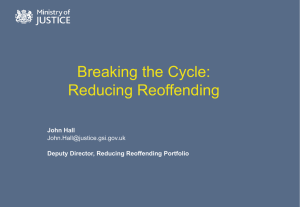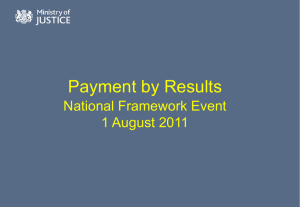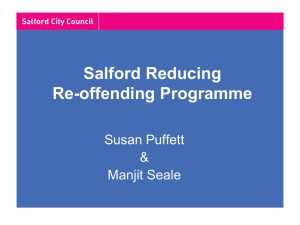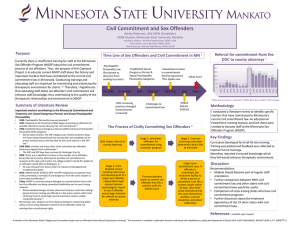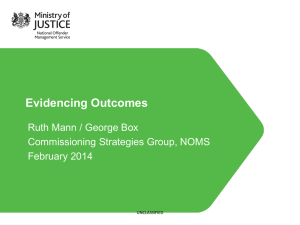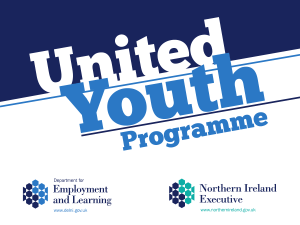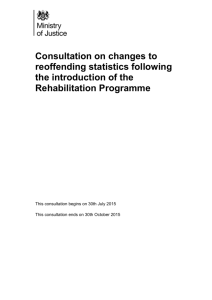Innovation pilots - Ministry of Justice
advertisement
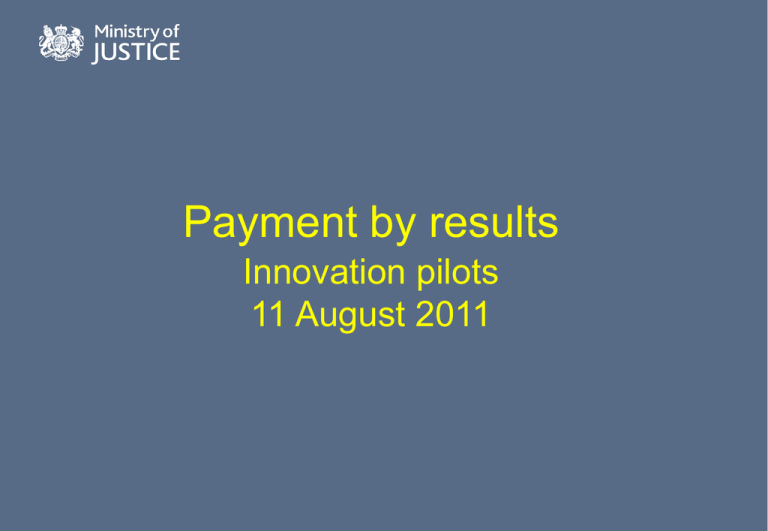
Payment by results Innovation pilots 11 August 2011 Crispin Blunt MP Minister for Prisons and Probation Ministry of Justice Helen Judge Director, Sentencing and Rehabilitation Ministry of Justice Today’s event • Update you on the payment by results programme • To set out the details of the innovation pilots • To discuss with you some of the opportunities and challenges • To hear your views • To help you consider whether you want to put your proposals forward for these pilots What has been committed to: The coalition Agreement stated the Government’s intention to: “pay independent providers to reduce reoffending, paid for by the savings this new approach will generate for the criminal justice system” The Green Paper outlines what this will mean in practice: New approach paying providers to reduce reoffending Ambition to apply the principles to all providers by 2015 At least six new pilots – with innovation pilots on top of this Supported by wider reforms over the next two years Payment by Results is really about….. A focus on Outcomes rather than process. Risk Transfer – ensuring that the financial risk for reductions in reoffending is transferred to the provider and not borne by the taxpayer Innovation – encouraged by giving increased discretion to providers and engaging a wide range of providers Principle is ‘we should pay for what works’ Innovation underlines our commitment to open up the payment by results market. We want to give you an opportunity to bring your ideas to us. We want to use these pilots as an opportunity to expand our understanding of what works. We have defined 4 pilot types….. • Prisons • Community • Justice Reinvestment • Innovation Progress so far…… Launched: • HMP Peterborough - Social Impact Bond • HMP Doncaster – Private Sector model • ‘Justice Reinvestment’ pilots in Greater Manchester and five London Boroughs In progress: • We have begun the innovation pilots programme • We are working with public sector prisons to consider a PbR pilot • We are working with probation trusts to consider a pilot working with offenders on licence and community sentences Luke Edwards Deputy Director, Reducing Reoffending: Payment by Results and Localism Ministry of Justice Why innovation? We must ensure our commissioning model harnesses the creativity and expertise that independent providers can bring. This includes small and specialist providers and social enterprises. Breaking the Cycle Green Paper, Page 41 • Enthusiasm for the sector but concerns about applying traditional commissioning routes • Aim of the pilots are to: • Genuinely test whether the enthusiasm and confidence can translate into concrete investment • Build the evidence base by testing different delivery models • Build a wider provider base with a demonstrable track record at reasonable scale • Enabling the potential new funding models to emerge • Enable the voluntary and other sectors to potentially engage in a different way with the process Innovation Pilots • We are proposing two opportunities for people to provide their ideas: Proposals focusing on those offenders sentenced to less than 12 months in custody Genuinely innovative ideas focusing on different types of offenders • We are interested in both innovative ways of: Delivering services; Commissioning services. • Intention is to compete over the summer for the ‘under 12 month proposals’, which means we will draw together a more detailed specification • Informal submissions for ‘other’ proposals for policy consideration in the autumn • Aim is to move into implementation phase for the under 12 months pilots from April 2011 depending on the nature of the proposal Offenders sentenced to less than 12 months • Ambition is for one or two pilots – depending on nature and size of proposals • We will be expecting ‘bidders’ to lead on the pilots - done with and not done to • Partnerships and investment will need to be secured by the bidders – we may provide a small amount of upfront investment to deliver the pilots if a rationale for this demonstrates it is necessary • We will pay on success. £20m has been allocated for success payments What will you need to think about? Measurement and attributation • Innovation is key but value for money remains a paramount consideration Cohort • You will need to define which offenders are you planning on working with? Will the pilot be sufficiently large to test your interventions at scale? Delivery model • What is your proposed model? Is it scalable and responsive? Is it supported by an evidence base? Funding • The first outcome payments are likely to be made in the third year. Working capital is critical. There is some scope for MoJ to provide initial working capital potentially linked to attachments or interim outcomes. Working in Partnership • Which organisations will be delivering your pilot? How will you work with the public sector? Have you considered consortia? Brian Farthing Economic Adviser, Analytical Services Ministry of Justice Key pilot design issues to consider… Which offenders should we focus on? • Focus is on offenders sentenced to less than 12 months in custody. • The cohort should be of sufficient size for payment and evaluation purposes. • The pilot should avoid overlap with other PbR initiatives. Which measure should we use? • Focus on outcome measures rather than inputs or outputs. • The measure should be aligned with a reduction in reoffending. • The measure should be SMART. How should we determine success? • The baseline should also be SMART. • Careful about factors that invalidate the baseline. • Changes from the baseline should be attributable (within reason) to interventions. How should we pay for success? • Our focus is on outcome based payments, with some scope for working capital outlays. • The timing of outcome payments should align with the measurement of outcomes. • Payment structures should incentivise intervention across the offender cohort. • Payments should offer value for money. Examples of existing payment by results schemes Peterborough SIB Doncaster prison Which offenders are focussed on? • Male offenders discharged from Peterborough prison sentenced to less than 12 months in custody. • Three cohorts of 1,000 offenders built up over a maximum of two years each. • Offenders discharged from Doncaster prison. • Annual offender cohorts estimated at 1,300. Which measure is used? • Average number of reconviction events across the offender cohort. • One year reconviction follow up period from date of discharge. • Percentage of offenders reconvicted across the cohort. • One year reconviction follow up period from date of discharge. How is success determined? • Matched ‘control group’ forms baseline. • Historic reoffending data forms baseline. • Threshold of success is established (i.e. outcome 10% lower than control group). • Threshold of success is established (i.e. outcome is 5% lower than baseline). How are payments for success made? • Outcome based payments made by MoJ/BLF. • Financing raised by Social Finance to fund interventions. • Fixed price per success beyond the threshold. • Total payments are capped. • Entire prison contract paid upfront. • 10% subject to payment by results and recovered by MoJ if threshold not met. • Extra fixed payments beyond threshold. • Total payments are capped. Session One Discussion about what you have heard: What are the key issues for you? What opportunities might this present? Ian Poree Director, Commissioning & Commercial National Offender Management Service Wider Context The Payment by Results pilot programme is a fundamental component of the recently published ‘Competition Strategy for Offender Services’. Further competitions in the first year include: • Custodial competitions - Further nine prisons to be competed this year • Community Competitions - Underway is the competition for community payback services in London. We will hold a competition to replace the existing Electronic monitoring services contracts due to expire in March 2013 Opportunities The Competition Strategy and the PbR pilots provide us with an opportunity to: • Move away from focusing on how providers deliver a particular service, and concentrate on what outcomes are required from a particular service • Deliver better outcomes for the taxpayers for less • Develop a diverse market of potential providers of Offender services • Stimulate providers from all sectors to innovative and better value services Innovation – longer term • Need to consider the policy/operational impacts of other proposals outside of the under 12 month group • We have a good understanding of the impact of tackling under 12 month offenders – and we would need to do the same for others • We need to do this on a longer timescale and consider the fit with the wider policy and delivery direction • We want both to hear your ideas and to engage with you on these proposals
